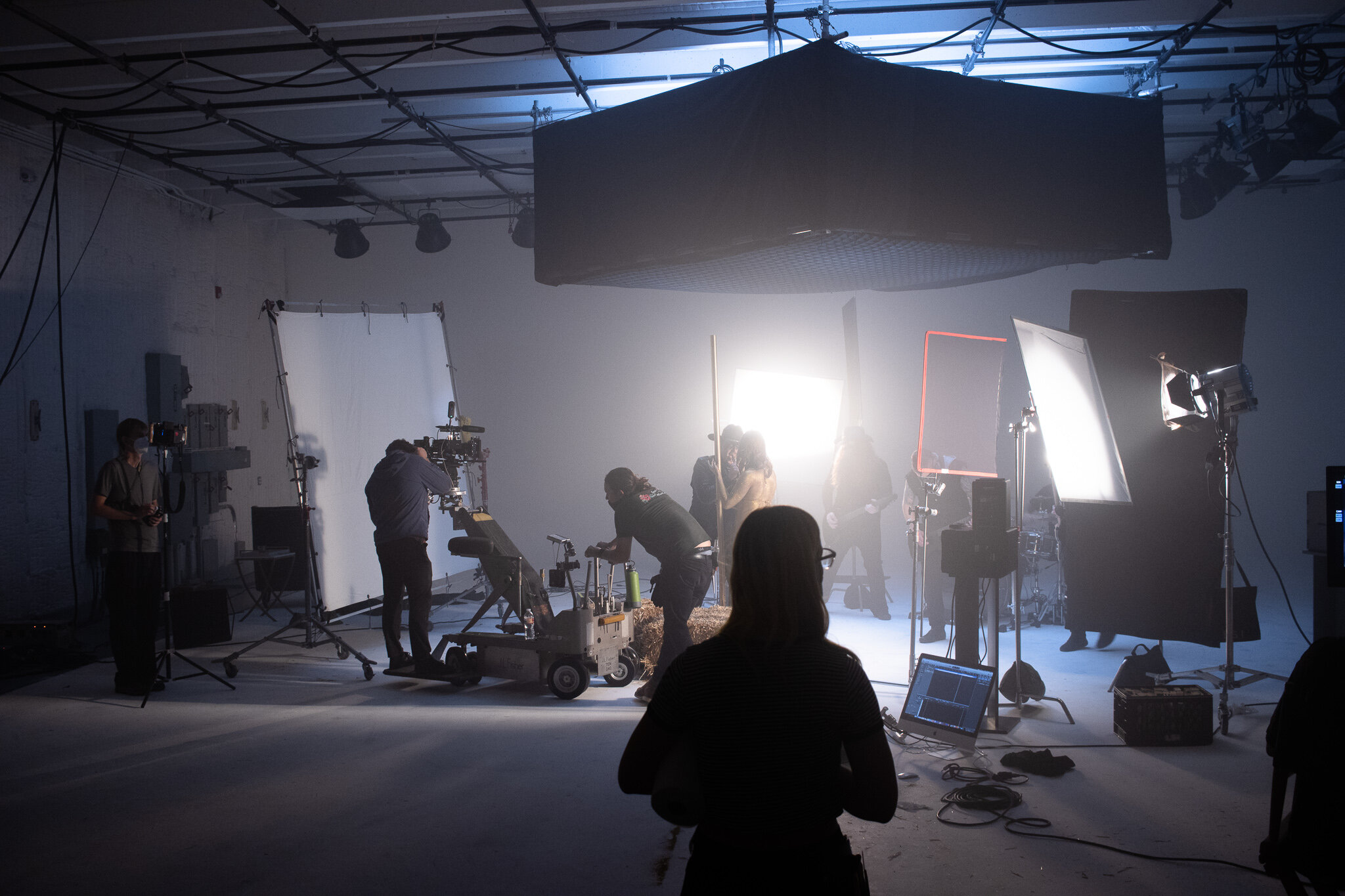Checking Out the most up to date Trends in Video Production for 2025
As we come close to 2025, the video production landscape is poised for significant advancement, defined by developments in augmented fact and AI-driven modifying devices. The assimilation of interactive narration and immersive 360-degree experiences is redefining target market engagement, while lasting production methods acquire prestige. Furthermore, enhanced real-time streaming abilities are readied to equalize material access like never ever before. These advancements raise crucial concerns about the future of imagination and technology in video production-- what ramifications will these trends hold for designers and customers alike?
Increased Reality in Video Production
Enhanced truth (AR) is positioned to revolutionize video production by effortlessly mixing electronic elements with live-action video footage. This cutting-edge technology improves narration by providing immersive experiences that engage audiences on a much deeper degree. AR allows filmmakers to include interactive graphics, animations, and info overlays directly into the real-world atmosphere captured on display, producing a dynamic seeing experience that standard methods can not attain.
In 2025, we can anticipate AR to become an indispensable part of various video production processes, from pre-production planning to post-production improvements. The capacity to envision intricate scenes and components in real-time will certainly enable directors and cinematographers to make informed decisions throughout recording. In addition, AR can facilitate remote cooperation, permitting staff member to connect with 3D versions and aesthetic results from various areas, consequently simplifying the production operations.
Additionally, advertising and marketing techniques will profit from AR combination, as brands increasingly leverage this modern technology to produce interesting and one-of-a-kind material. As customer need for interactive and ingenious experiences proceeds to grow, AR will certainly play a necessary function fit the future of video production, driving creativity and increasing the possibilities for filmmakers.
AI-Powered Editing And Enhancing Tools
As the video production landscape progresses, AI-powered editing and enhancing tools are arising as a video game changer. These tools use enhanced automation functions that simplify workflows, promote real-time collaboration among groups, and present enhanced interface for an extra user-friendly editing experience. Comprehending these advancements is necessary for professionals looking for to remain competitive in the sector.
Improved Automation Features
The surge of AI-powered editing devices is established to transform the video production landscape, streamlining process and improving creative opportunities. These enhanced automation functions are developed to decrease manual work, enabling material designers to focus more on narration and artistic vision. By leveraging artificial intelligence algorithms, these tools can evaluate video footage, determine essential moments, and suggest perfect cuts, considerably lowering editing and enhancing time.
Among the most exceptional improvements is the capability of AI to comprehend and adapt to various modifying styles. This capability makes it possible for editors to use certain visual appeals or genres to their projects efficiently, promoting an extra individualized technique. AI-driven shade grading and sound editing tools can immediately enhance audio and visual top quality, guaranteeing a professional coating without comprehensive hand-operated modifications.

Real-Time Partnership Conveniences
Real-time partnership is coming to be increasingly necessary in video production, particularly with the development of AI-powered editing and enhancing devices. These ingenious modern technologies make it possible for multiple stakeholders, including supervisors, editors, and customers, to collaborate effortlessly, despite their physical locations. By promoting immediate comments and revisions, AI-powered platforms boost the imaginative process, allowing teams to choose rapidly and effectively.
Among the crucial benefits of real-time cooperation is the capacity to leverage AI for data-driven insights. As an example, AI algorithms can analyze footage and suggest edits or shifts that align with the project's vision, streamlining the workflow. This not only speeds up the modifying process but also assures that imaginative selections are notified by historical information and sector fads.

Improved Customer Interfaces
Innovative customer interfaces in AI-powered modifying devices are transforming the video production landscape by boosting the individual experience and streamlining operations. These tools utilize advanced formulas to simplify intricate editing jobs, allowing designers to focus a lot more on storytelling and imagination instead of technical details.
One essential innovation is the integration of instinctive drag-and-drop functionalities, which allow individuals to construct their jobs effortlessly. Coupled with real-time comments devices, editors can visualize modifications immediately, lowering the time spent on modifications. Additionally, AI-driven features such as automatic scene discovery and smart shade grading provide ideas based upon task context, greatly speeding up the modifying procedure.
In addition, the surge of personalized interfaces allows users to customize their work space to fit specific choices, enhancing efficiency and effectiveness. Editors can prioritize attributes and devices they utilize most usually, making the most of and minimizing distractions operations fluidity. - Video Production
As these AI-powered editing and enhancing tools continue to evolve, their boosted customer interfaces are set to redefine sector requirements, making top notch video production available to a broader array of makers. This pattern not only equalizes video editing however also cultivates development in material creation, establishing the phase for interesting developments in 2025 and beyond.
Interactive Narration Techniques
As video production advances, interactive storytelling methods are becoming necessary for creating immersive customer experiences. By incorporating branching narrative structures, makers can offer audiences a personalized journey with the web content, enhancing interaction. Additionally, real-time audience engagement allows for dynamic narration that adjusts to viewer options, cultivating a deeper connection with the material.
Immersive Customer Experiences
The evolution of immersive audience experiences is changing the landscape of interactive narration techniques, enabling audiences to involve with stories in extraordinary ways. By incorporating online truth (VIRTUAL REALITY), augmented reality (AR), and mixed reality (MR) technologies, developers are crafting atmospheres where customers do not simply observe tales however actively take part in them. This shift towards immersion promotes a sense of presence and psychological financial investment, changing easy usage into dynamic exploration.
Advancements in 360-degree video and spatial audio better boost these experiences, making it possible for customers to engage and navigate with their surroundings. Such technologies facilitate a multi-sensory method to storytelling, where visual and acoustic aspects are elaborately woven together to develop a natural narrative. This not just astounds the target market but additionally urges deeper links to the web content.
The increase of interactive platforms is equipping developers to experiment with non-linear stories, providing target markets the capability to influence results and character arcs in actual time. As immersive customer experiences continue to develop, they are established to redefine just how tales are told and received, leading the way for innovative kinds of web content that reverberate with diverse audiences around the world.
Branching Narrative Frameworks
Structure upon the immersive viewer experiences that have actually changed interactive narration, branching narrative structures are emerging as an effective technique to further engage audiences. These frameworks permit visitors to affect the direction of the narrative, creating a much more customized and dynamic experience. By using several pathways and results, material creators can cater to diverse target market preferences and foster much deeper emotional links with the material.
As technology breakthroughs, the application of branching narratives has actually become more innovative. Modern systems enable smooth shifts in between choices, boosting the audience's feeling of agency. This interactivity not just captivates target markets but likewise encourages repeated watchings, as users discover alternate stories and closings.
Moreover, branching narratives can be see this successfully integrated right into different categories, from video gaming to movie and instructional web content. This convenience opens new methods for storytelling, allowing designers to trying out complex character arcs and complex stories. As we move into 2025, the relevance of branching narrative frameworks in video production will likely remain to grow, reshaping exactly how tales are informed and experienced, inevitably redefining the relationship between developers and their target markets
Real-Time Target Market Involvement
Real-time target market involvement is revolutionizing interactive storytelling by making it possible for makers to get in touch with viewers in unprecedented methods. This ingenious technique enables target markets to affect stories as they unravel, boosting immersion and psychological investment. With innovations in modern technology, such as real-time ballot, conversation assimilation, and boosted fact, visitors can get involved proactively, choosing that form the instructions of the story in real-time.
Platforms leveraging these strategies are not just redefining conventional narration however also fostering community interaction. By integrating functions like online Q&A sessions and interactive personality discussions, developers can build deeper connections with their audience, making sure an extra individualized watching experience. Because of this, narratives come to be much more vibrant, adapting to audience comments and preferences quickly.
Real-time involvement enhances information collection, offering important insights into visitor behavior and preferences. This details can direct future productions, refining web content methods to much better reverberate with target demographics. As we approach 2025, the combination of real-time audience involvement right into video production will likely become a common method, transforming exactly how tales are informed and experienced. The advancement of interactive narration is not merely an enhancement; it is a necessary shift in the direction of an extra appealing and participatory narrative structure
360-Degree Video Experiences
Immersive video experiences are established to redefine material consumption in 2025, as improvements in technology continue to blur the lines in between truth and online interaction. The increase of 360-degree video and increased fact (AR) is transforming exactly how audiences communicate with content, developing possibilities for much deeper emotional connections and personalized narration.
With the proliferation of budget friendly VR headsets and mobile phones efficient in sustaining high-grade immersive content, creators can currently create videos that position audiences at the center of the action - Creative Video Production. This shift not only improves customer interaction but also enables brand names to produce one-of-a-kind experiences that reverberate with their target audiences. As an example, traveling companies can provide virtual scenic tours of destinations, while academic organizations can replicate complex atmospheres for immersive knowing

Sustainable Production Practices
As the video production landscape progresses with cutting-edge technologies like 360-degree experiences, the industry is likewise progressively focusing on lasting production practices. Acknowledging the ecological effect of traditional filming methods, production business are adopting green initiatives to decrease their carbon footprint.
One significant fad is the usage of renewable resource resources, such as solar and wind power, to sustain production sets. This shift not only minimizes dependence on nonrenewable fuel sources but also decreases functional costs in the future. Additionally, numerous business are implementing digital procedures to restrict paper use, consequently promoting a more lasting process.
Moreover, the idea of a round economic climate is acquiring traction, motivating filmmakers to recycle and recycle products whenever feasible. By choosing sustainable set styles and outfits, production teams decrease waste and promote a culture of environmental obligation.
Partnership with regional communities and organizations additionally plays an essential duty in lasting practices, as it promotes regional economic situations and lowers transport discharges. On the whole, the dedication to sustainability in video production mirrors a more comprehensive societal shift in the direction of ecological stewardship, ensuring that future generations can proceed to take pleasure in cinematic storytelling without endangering the world's health.
Boosted Online Streaming
The future of video production is being reshaped by improved real-time streaming capabilities, which are transforming exactly how target markets engage with material. As modern technology breakthroughs, real-time streaming is coming to be extra obtainable and interactive, permitting developers to get in touch with viewers in real-time. This change not just enhances audience involvement however additionally promotes a sense of area around shared experiences.
With the integration of high-def video and audio top quality, combined with low-latency streaming, audiences currently delight in seamless programs that rival traditional television. Platforms are increasingly including functions such as multi-camera arrangements, interactive polls, and audience Q&A sessions, making live events a lot more dynamic and interesting.
The increase of decentralized streaming methods ensures far better reliability and scalability, allowing material creators to reach larger target markets without jeopardizing high quality. As brand names and influencers profit from these developments, the potential for cutting-edge marketing strategies via online streaming comes to be apparent.
In 2025, we can expect more developments in enhanced fact overlays and enhanced analytics, empowering designers to improve their content and customize it to audience choices. Enhanced live streaming is not simply a trend; it is a crucial component shaping the future of material usage and production.
Online Fact Assimilation
With enhanced real-time streaming setting the phase for more interactive experiences, online reality (VR) combination is positioned to take target market interaction to unmatched levels. As we come close to 2025, the merging of virtual reality technology with video production is changing how material is created and consumed. By immersing visitors in a 360-degree setting, producers can provide special experiences that traditional formats can not match.
Brands are increasingly leveraging VR to develop engaging stories that resonate deeply with audiences. This integration enables for experiential advertising, where consumers can communicate with services or products in a virtual room, cultivating an extra individual connection. Events such as digital performances, item launches, and immersive storytelling sessions are becoming commonplace, engaging customers in means that boost retention and emotional investment.
Additionally, innovations in software and hardware are making VR more obtainable to creators, causing a more comprehensive variety of content. As production expenses lower and easy to use tools arise, we can expect a rise in ingenious virtual reality jobs across different industries, from home entertainment to education and learning. The future of video production depends on these immersive experiences, redefining storytelling and target market communication in the digital landscape.
Frequently Asked Inquiries
What Are the Important Abilities for Video Producers in 2025?
Necessary skills for video manufacturers in 2025 consist of sophisticated technological effectiveness in modifying software application, strong narration abilities, versatility to arising technologies, partnership abilities for varied teams, and a keen understanding of audience involvement techniques throughout systems. Video Production NYC.
Exactly How Can Independent Creators Access Advanced Video Production Technologies?
Independent designers can access innovative video production technologies with cost effective software application systems, cloud-based editing tools, open-source sources, and online programs. Collaborations with technology firms and leveraging area resources also improve access to sophisticated production devices.
What Are the Potential Costs Associated With These New Video Production Trends?
The potential costs related to emerging video production patterns can vary significantly, including costs for advanced devices, software application licenses, training, and workers. Budgeting efficiently is necessary for designers to utilize these advancements without spending beyond your means.
Just How Can I Determine the Success of My Video Production Efforts?
To measure the success of your video production initiatives, assess vital performance indicators such as viewer involvement, conversion prices, audience retention, and feedback. Make use of analytics devices to gather information and acquire workable insights for future renovations.
What Industries Are The Majority Of Affected by Video Production Trends in 2025?
Industries such as advertising, health care, education, and enjoyment are significantly influenced by emerging video production fads. These industries significantly utilize cutting-edge techniques to boost engagement, enhance interaction, and provide engaging web content to their respective target markets.
Cutting-edge user interfaces in AI-powered editing and enhancing tools are transforming the video production landscape by boosting the user experience and improving operations. As we approach 2025, the integration of real-time target market involvement into video production will likely end up being a typical practice, transforming exactly how tales are informed and experienced. As the video production landscape develops with ingenious innovations like 360-degree experiences, the sector is also increasingly prioritizing lasting production techniques. The future of video production is being reshaped by enhanced online streaming abilities, which are revolutionizing exactly how target markets involve with content. To determine the success of your video production efforts, assess key performance signs such as customer interaction, conversion prices, target market retention, and responses.